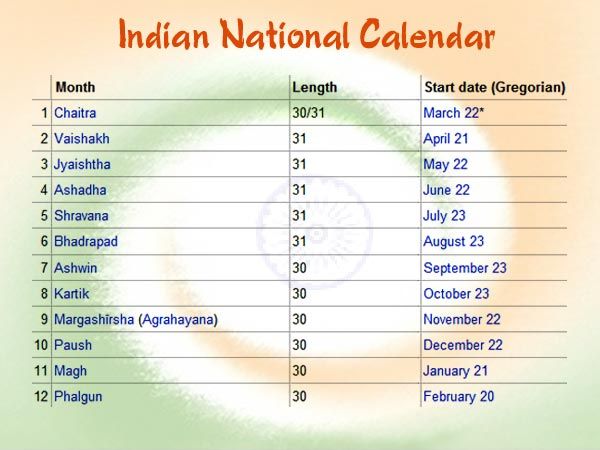Important Key Facts About the National Calendar of India – A Symbol of Unity & Tradition!
The National Calendar of India, also known as the Saka Calendar, is an integral part of India’s identity. It represents the nation’s cultural heritage while aligning with modern scientific calculations. Introduced officially in 1957, the Saka Calendar is used for official government purposes, including the Gazette of India, news broadcasts, and calendars issued by the government.
But how did this calendar come into existence? Why was it adopted, and how does it impact daily life? Let’s dive into the history, significance, and impact of the National Calendar of India in this article.
All About the National Calendar of India
Basic Features of the Saka Calendar
- Officially adopted: March 22, 1957
- Starting Year: 78 AD (Saka Era)
- Months: 12 (Same as the Gregorian Calendar but with different names)
- First Month: Chaitra (Begins on March 21/22 in normal years and March 20/21 in leap years)
- Days per month: Varies between 30 and 31
- Leap Year System: Follows the same rule as the Gregorian calendar (every 4th year is a leap year)
The Saka Calendar is primarily solar-based, meaning it follows the movement of the Sun rather than the Moon. This makes it scientifically accurate and easy to integrate with the widely used Gregorian Calendar.
Months in the Saka Calendar
| Saka Month | Duration (Days) | Corresponding Gregorian Month |
|---|---|---|
| Chaitra | 30/31 | March-April |
| Vaishakha | 31 | April-May |
| Jyeshtha | 31 | May-June |
| Ashadha | 31 | June-July |
| Shravana | 31 | July-August |
| Bhadrapada | 31 | August-September |
| Ashwin | 30 | September-October |
| Kartika | 30 | October-November |
| Agrahayana | 30 | November-December |
| Pausha | 30 | December-January |
| Magha | 30 | January-February |
| Phalguna | 30 | February-March |
History of the National Calendar of India
Before independence, India followed multiple regional and religious calendars. However, after independence, the need for a unified, scientific, and standard national calendar was felt.
In 1952, the Calendar Reform Committee, led by famous astrophysicist Meghnad Saha, was formed to create a uniform calendar system for India. The committee analyzed various traditional Hindu, Buddhist, and Islamic calendars and recommended adopting the Saka Calendar as the National Calendar of India.
It was officially adopted on March 22, 1957, by the Government of India and has since been used for official documentation and government publications.
Significance of the National Calendar of India
1️⃣ Cultural Unity – Before the Saka Calendar, India had over 30 different regional calendars, creating confusion in official communication. The Saka Calendar helped create a standardized system while respecting India’s diversity.
2️⃣ Scientific Accuracy – The solar-based system ensures that the calendar aligns with the seasons and astronomical movements, making it highly precise.
3️⃣ Official Government Use – The National Calendar is used in the Gazette of India, All India Radio broadcasts, and government calendars, ensuring consistency in documentation.
4️⃣ Integration with the Gregorian Calendar – Since it runs parallel with the Western calendar, it is easy to use in modern India.
5️⃣ Connection to India’s Ancient Heritage – The Saka Era began in 78 AD, making it a historical link to India’s past.
Daily Life Impacts of the Saka Calendar: National Calendar of India
✅ Official Communication – Government documents and official records use both the Saka and Gregorian dates, ensuring accuracy.
✅ Festivals & Religious Observances – Many Hindu, Buddhist, and Sikh festivals still follow the lunar or solar calculations based on the Saka Calendar.
✅ Education & Awareness – Schools and institutions educate students about India’s unique calendar system, promoting national heritage.
✅ Indian Railways & Weather Reports – Some railway timetables and meteorological reports also reference Saka dates.
✅ Regional Adaptation – Many states have incorporated Saka dates in their local calendars, blending traditional and modern timekeeping.
Interesting Facts About the Saka Calendar: National Calendar of India
🕰️ Fact 1: The Saka Calendar was first proposed in 1952, but it took five years to be officially implemented.
🕰️ Fact 2: Unlike other ancient Indian calendars based on the moon, the Saka Calendar is purely solar-based, making it more stable.
🕰️ Fact 3: India’s financial and taxation year (April-March) roughly aligns with the Saka Calendar.
🕰️ Fact 4: The first day of Chaitra (March 22) is celebrated as Saka New Year in some Indian states.
🕰️ Fact 5: The Indian National Calendar was officially declared by then-Prime Minister Jawaharlal Nehru.
Observance & Celebration of the Saka Calendar: National Calendar of India
While the Saka Calendar is primarily used for official purposes, it is also observed in cultural and regional celebrations.
Key Events & Observances
📅 Saka New Year (Chaitra 1st) – Celebrated in some regions like Maharashtra (Gudi Padwa) and Karnataka (Ugadi).
📅 Government Calendar Release – The Indian government issues its annual calendar based on Saka dates.
📅 Integration in National Media – All India Radio (AIR) and Doordarshan mention Saka dates in news bulletins.
FAQs About the National Calendar of India
1. Why was the Saka Calendar adopted as India’s National Calendar?
It was chosen for its scientific accuracy, cultural significance, and ease of integration with the Gregorian calendar.
2. Is the Saka Calendar still in use today?
Yes, it is used in official government records, All India Radio, and national publications.
3. How does the Saka Calendar compare to the Gregorian Calendar?
The Saka Calendar starts in 78 AD, while the Gregorian Calendar begins with the birth of Christ (1 AD).
4. Which states celebrate the Saka New Year?
States like Maharashtra (Gudi Padwa), Karnataka (Ugadi), and Andhra Pradesh follow variations of the Saka New Year.
5. Does India use only the Saka Calendar?
No, India also follows the Gregorian Calendar for global compatibility, but the Saka Calendar is used for official purposes.
Wishing Someone on the Saka New Year
🗓️ “May the New Year in the National Calendar bring prosperity and happiness into your life. Happy Saka New Year!”
🎉 “Let’s celebrate our heritage and traditions with pride. Wishing you a joyful Saka Era New Year!”
Final Thoughts: National Calendar of India
The National Calendar of India is not just a timekeeping system; it represents India’s unity, heritage, and scientific progress. While the Gregorian Calendar dominates daily life, the Saka Calendar keeps India connected to its cultural roots. By recognizing and preserving it, we celebrate India’s rich history and traditions.
Would you like to see the Saka Calendar being used more widely? Share your thoughts in the comments! 📅💬










